企业成本控制分析外文翻译
企业成本控制外文翻译文献
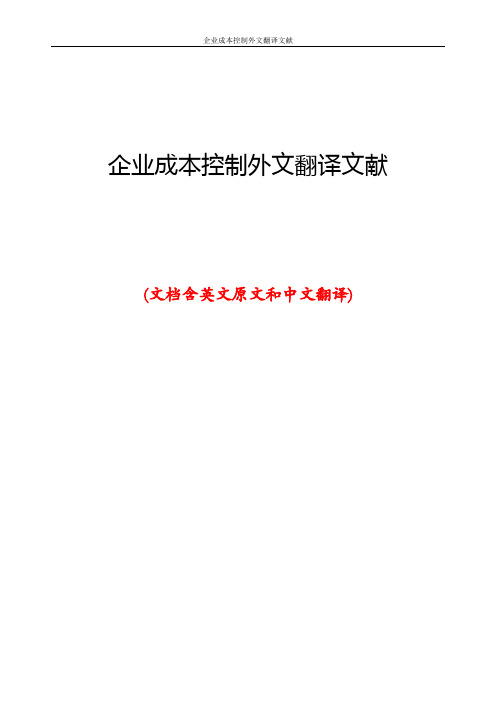
企业成本控制外文翻译文献(文档含英文原文和中文翻译)译文:在价值链的成本控制下减少费用和获得更多的利润摘要:根据基于价值链的成本管理理念和基于价值的重要因素是必要的。
首先,必须有足够的资源,必须创造了有利的价值投资,同时还需要基于客户价值活动链,以确定他们的成本管理优势的价值链。
其次,消耗的资源必须尽量减少,使最小的运营成本价值链和确保成本优势是基于最大商业价值或利润,这是一种成本控制系统内部整个视图的创建和供应的具实践,它也是一种成本控制制度基于价值链,包括足够的控制和必要的资源投资价值的观点,创建和保持消费的资源到合理的水平,具有价值的观点主要对象的第一个因素是构造有利的价值链,从创造顾客价值开始;第二个因素是加强有利的价值链,从供应或生产客户价值开始。
因此它是一个新型的理念,去探索成本控制从整个视图的创建和供应的商品更盈利企业获得可持续的竞争优势。
关键词:成本控制,价值链,收益,支出,收入,成本会计1、介绍根据价值链理论,企业的目的是创造最大的顾客价值;和企业的竞争优势在于尽可能提供尽可能多的价值给他们的客户,作为低成本可能的。
这要求企业必须首先考虑他们是否能为顾客创造价值,和然后考虑在很长一段时间内如何创造它。
然而,竞争一直以“商品”(或“产品”)作为最直接的载体,因此,传统的成本控制方法主要集中在对“产品”和生产流程的过程。
很显然,这不能解决企业的问题,企业是否或如何能为客户创造价值。
换句话说,这至少不能从根本上解决它。
因此,企业必须首先投入足够的资源,以便他们能够创建客户值取向,然后提供它以最少的资源费用。
所以在整个视图中对价值创造和提供整体的观点来控制成本,它可以为客户提供完美的动力和操作运行机制运行成本的控制,也可以从根本上彻底克服了传统的成本控制方法的缺点,解决了无法控制的创造和供应不足的真正价值。
基于此,本文试图从创作的整体观讨论成本控制提供价值并探讨实现良性循环的策略,也就是说,“创造价值投资成本供应价值创造价值”。
企业并购财务风险分析 外文文献翻译

文献出处:Biao D. Analysis of Financial Risk Prevention in Mergers and Acquisitions[J]. International Business and Management, 2014, 9(2): 138-144.第一部分为译文,第二部分为原文。
默认格式:中文五号宋体,英文五号Times New Roma,行间距1.5倍。
企业并购财务风险的预防管理分析摘要:并购被认为是改善企业管理模式,扩大企业规模,调整产业结构的有效途径。
这种方法在世界各地的每一次盛行中都受到很多因素的影响,然而企业并购在中国的起步较晚。
复杂而快速变化的环境使得企业并购具有重大风险。
特别是并购流程每一步都有严重的财务风险。
并购存在各种财务风险,如果这些风险没有得到有效的解决和控制,任何时候都会导致企业失败。
因此,许多学者和企业家认为兼并和收购的财务风险是最大的问题。
本文将对并购财务风险提出有效的预防措施,减少财务风险带来的影响,增加并购成功机会,确保企业并购的实施。
关键词:并购,财务风险,因果关系,预防引言自1897年以来,西方资本主义国家的并购遭遇了五次浪潮。
每次并购对企业的结构优化和资源配置都起着重要的作用。
中国改革开放政策实施后,随着经济全球化的快速发展,并购成为企业扩大经营规模,实现国际化的重要途径之一。
20世纪80年代中国出现并购,当时并购行为在中国企业受到欢迎,尽管许多企业从事并购,但成功案例少。
因为并购行为有很多潜在风险,其中包括市场风险,财务风险,法律风险等。
然而,财务风险被认为是并购的主要问题。
因此,有必要研究并购和财务风险的内容,了解财务风险的特点及其影响,系统分析财务风险,具体来说,需要研究并购前的目标企业的定价风险,并购期间的支付风险和财务风险以及并购后的整合风险。
最后,本文提出了基于各种风险的预防和控制措施,这是降低财务风险并提高并购成功概率的有效途径。
成本管理外文文献及翻译
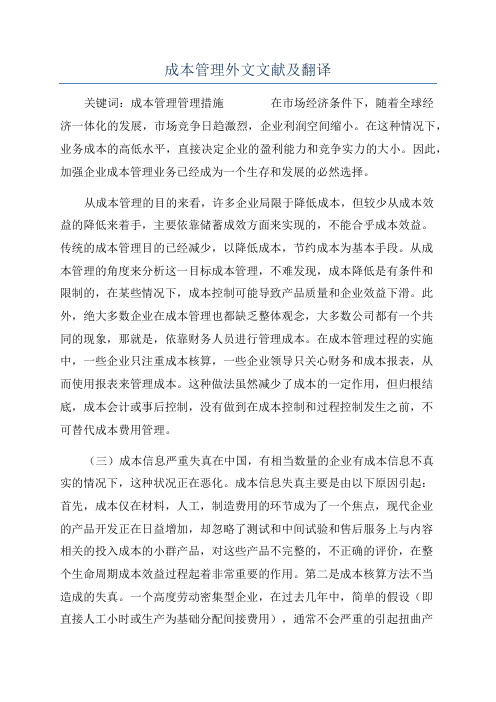
成本管理外文文献及翻译关键词:成本管理管理措施在市场经济条件下,随着全球经济一体化的发展,市场竞争日趋激烈,企业利润空间缩小。
在这种情况下,业务成本的高低水平,直接决定企业的盈利能力和竞争实力的大小。
因此,加强企业成本管理业务已经成为一个生存和发展的必然选择。
从成本管理的目的来看,许多企业局限于降低成本,但较少从成本效益的降低来着手,主要依靠储蓄成效方面来实现的,不能合乎成本效益。
传统的成本管理目的已经减少,以降低成本,节约成本为基本手段。
从成本管理的角度来分析这一目标成本管理,不难发现,成本降低是有条件和限制的,在某些情况下,成本控制可能导致产品质量和企业效益下滑。
此外,绝大多数企业在成本管理也都缺乏整体观念,大多数公司都有一个共同的现象,那就是,依靠财务人员进行管理成本。
在成本管理过程的实施中,一些企业只注重成本核算,一些企业领导只关心财务和成本报表,从而使用报表来管理成本。
这种做法虽然减少了成本的一定作用,但归根结底,成本会计或事后控制,没有做到在成本控制和过程控制发生之前,不可替代成本费用管理。
(三)成本信息严重失真在中国,有相当数量的企业有成本信息不真实的情况下,这种状况正在恶化。
成本信息失真主要是由以下原因引起:首先,成本仅在材料,人工,制造费用的环节成为了一个焦点,现代企业的产品开发正在日益增加,却忽略了测试和中间试验和售后服务上与内容相关的投入成本的小群产品,对这些产品不完整的,不正确的评价,在整个生命周期成本效益过程起着非常重要的作用。
第二是成本核算方法不当造成的失真。
一个高度劳动密集型企业,在过去几年中,简单的假设(即直接人工小时或生产为基础分配间接费用),通常不会严重的引起扭曲产品成本的核算。
但在现代制造业环境中,直接劳动成本所占的比例显著下降,而制造成本的比例大幅增加,因此,使用传统的成本计算方法会产生不合理的行为,利用传统的成本核算,在产品成本信息中将导致严重的扭曲,使企业错误的选择产品的方向。
财务管理外文文献及翻译
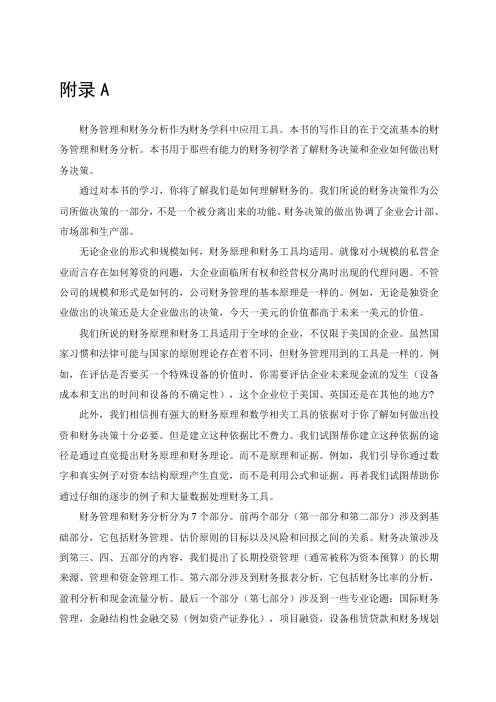
附录A财务管理和财务分析作为财务学科中应用工具。
本书的写作目的在于交流基本的财务管理和财务分析。
本书用于那些有能力的财务初学者了解财务决策和企业如何做出财务决策。
通过对本书的学习,你将了解我们是如何理解财务的。
我们所说的财务决策作为公司所做决策的一部分,不是一个被分离出来的功能。
财务决策的做出协调了企业会计部、市场部和生产部。
无论企业的形式和规模如何,财务原理和财务工具均适用。
就像对小规模的私营企业而言存在如何筹资的问题,大企业面临所有权和经营权分离时出现的代理问题。
不管公司的规模和形式是如何的,公司财务管理的基本原理是一样的。
例如,无论是独资企业做出的决策还是大企业做出的决策,今天一美元的价值都高于未来一美元的价值。
我们所说的财务原理和财务工具适用于全球的企业,不仅限于美国的企业。
虽然国家习惯和法律可能与国家的原则理论存在着不同,但财务管理用到的工具是一样的。
例如,在评估是否要买一个特殊设备的价值时,你需要评估企业未来现金流的发生(设备成本和支出的时间和设备的不确定性),这个企业位于美国、英国还是在其他的地方?此外,我们相信拥有强大的财务原理和数学相关工具的依据对于你了解如何做出投资和财务决策十分必要。
但是建立这种依据比不费力。
我们试图帮你建立这种依据的途径是通过直觉提出财务原理和财务理论。
而不是原理和证据。
例如,我们引导你通过数字和真实例子对资本结构原理产生直觉,而不是利用公式和证据。
再者我们试图帮助你通过仔细的逐步的例子和大量数据处理财务工具。
财务管理和财务分析分为7个部分。
前两个部分(第一部分和第二部分)涉及到基础部分,它包括财务管理、估价原则的目标以及风险和回报之间的关系。
财务决策涉及到第三、四、五部分的内容,我们提出了长期投资管理(通常被称为资本预算)的长期来源、管理和资金管理工作。
第六部分涉及到财务报表分析,它包括财务比率的分析,盈利分析和现金流量分析。
最后一个部分(第七部分)涉及到一些专业论题:国际财务管理,金融结构性金融交易(例如资产证券化),项目融资,设备租赁贷款和财务规划策略。
成本控制中英文对照外文翻译文献
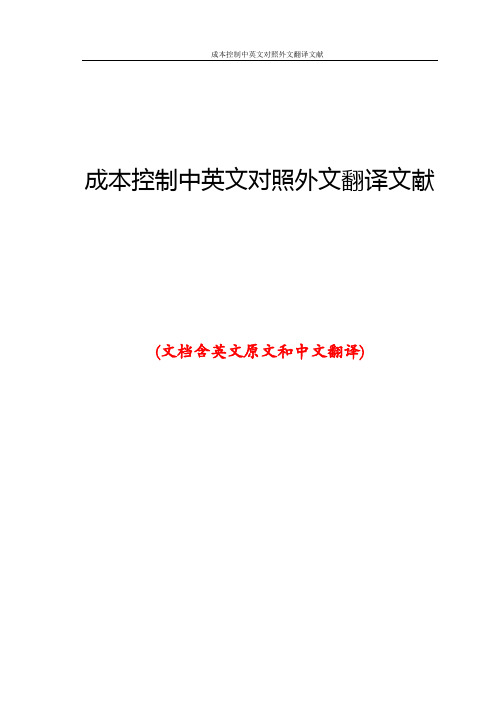
成本控制中英文对照外文翻译文献(文档含英文原文和中文翻译)原文:COST CONTROLRoger J. AbiNaderReference for Business,Encyclopedia of Business, 2nd ed.Cost control, also known as cost management or cost containment, is a broad set of cost accountingmethods and management techniques with the common goal of improving business cost-efficiency by reducing costs, or at least restricting their rate of growth. Businesses use cost control methods to monitor, evaluate, and ultimately enhance the efficiency of specific areas, such as departments, divisions, or product lines, within their operations.Control of the business entity , then, is essentially a managerial and supervisory function .Control consiets of those actions necessary to assur e that the entity’s resources and operations are focused on attaining established objectives , goals and plans. Control, exercised continuously, flags potential problems so that crises may be prevented. It also standardizeds the quantity of output , and provides managers with objective information about employee performance . Management compares actual performance to predetermined standards and takes action when necessary to correct variances from the standards.Keywords : Cost control, Applications, Control reports, Standards, Strategic Cost control, also known as cost management or cost containment, is a broad set of cost accountingmethods and management techniques with the common goal of improving business cost-efficiency by reducing costs, or at least restricting their rate of growth. Businesses use cost control methods to monitor, evaluate, and ultimately enhance the efficiency of specific areas, such as departments, divisions, or product lines, within their operations.During the 1990s cost control initiatives received paramount attention from corporate America. Often taking the form of corporate restructuring, divestmentof peripheral activities, mass layoffs,or outsourcing,cost control strategies were seen as necessary to preserve—or boost—corporate profits and to maintain—or gain—a competitive advantage. The objective was often to be the low-cost producer in a given industry, which would typically allow the company to take a greater profit per unit of sales than its competitors at a given price level.Some cost control proponents believe that such strategic cost-cutting must be planned carefully, as not all cost reduction techniques yield the same benefits. In a notable late 1990s example, chief executive Albert J. Dunlap, nicknamed "Chainsaw Al" because of his penchant for deep cost cutting at the companies he headed, failed to restore the ailing small appliance maker Sunbeam Corporation to profitability despite his drastic cost reduction tactics. Dunlap laid off thousands of workers and sold off business units, but made little contribution to Sunbeam's competitive position or share price in his two years as CEO. Consequently, in 1998 Sunbeam's board fired Dunlap, having lost confidence in his "one-trick" approach to management.COST CONTROL APPLICATIONSA complex business requires frequent information about operations in order to plan for the future, to control present activities, and to evaluate the past performance of managers, employees, and related business segments. To be successful, management guides the activities of its people in the operations of the business according to pre-established goal and objectives. Management’s guidance takestwo forms of control: (1) the management and supervision of behuvior , and (2) the evaluation of performance.Behavioral management deals with the attitudes and actions of employees. While employee behavior ultimately impacts on success, behavioral management involves certain issues and assumptions not applicable to accounting's control function. On the other hand, performance evaluation measures outcomes of employee's actions by comparing the actual results of business outcomes to predetermined standards ofsuccess. In this way management identifies the strengths it needs to maximize, and the weaknesses it seeks to rectify. This process of evaluation and remedy is called cost control.Cost control is a continuous process that begins with the proposed annual budget. The budget helps: (1) to organize and coordinate production, and the selling, distribution, service, and administrative functions; and (2) to take maximum advantage of available opportunities. As the fiscal year progresses, management compares actual results with those projected in the budget and incorporates into the new plan the lessons learned from its evaluation of current operations.Control refers to management's effort to influence the actions of individuals who are responsible for performing tasks, incurring costs, and generating revenues. Management is a two-phased process: planningrefers to the way that management plans and wants people to perform, while controlrefers to the procedures employed to determine whether actual performance complies with these plans. Through the budget process and accounting control, management establishes overall company objectives, defines the centers of responsibility, determines specific objectives for each responsibility center, and designs procedures and standards for reporting and evaluation.A budget segments the business into its components or centers where the responsible party initiates and controls action. Responsibility centersrepresent applicable organizational units, functions, departments, and divisions. Generally a single individual heads the responsibility center exercising substantial, if not complete, control over the activities of people or processes within the center and controlling the results of their activity. Cost centersare accountable only for expenses, that is, they do not generate revenue. Examples include accounting departments, human resources departments, and similar areas of the business that provide internal services. Profit centersaccept responsibility for both revenue and expenses. For example, a product line or an autonomous business unit might be considered profit centers. If the profit center has its own assets, it may also be considered an investment center,for which returns on investment can be determined. The use of responsibility centers allows management todesign control reports to pinpoint accountability, thus aiding in profit planning.A budget also sets standards to indicate the level of activity expected from each responsible person or decision unit, and the amount of resources that a responsible party should use in achieving that level of activity. A budget establishes the responsibility center, delegates the concomitant responsibilities, and determines the decision points within an organization.The planning process provides for two types of control mechanisms:Feedforward: providing a basis for control at the point of action (the decision point); andFeedback: providing a basis for measuring the effectiveness of control after implementation.Management's role is to feedforwarda futuristic vision of where the company is going and how it is to get there, and to make clear decisions coordinating and directing employee activities. Management also oversees the development of procedures to collect, record, and evaluate feedback.Therefore, effective management controls results from leading people by force of personality and through persuasion; providing and maintaining proper training, planning, and resources; and improving quality and results through evaluation and feedback.Control reports are informational reports that tell management about an entity's activities. Management requests control reports only for internal use, and, therefore, directs the accounting department to develop tailor-made reporting formats. Accounting provides management with a format designed to detect variations that need investigating. In addition, management also refers to conventional reports such as the income statement and funds statement, and external reports on the general economy and the specific industry.Control reports, then, need to provide an adequate amount of information so that management may determine the reasons for any cost variances from the original budget.A good control report highlights significant information by focusing management's attention on those items in which actual performance significantly differs from thestandard.Because key success factors shift in type and number, accounting revises control reports when necessary. Accounting also varies the control period covered by the control report toencompass a period in which management can take useful remedial action. In addition, accountingdisseminates control reports in a timely fashion to give management adequate time to act before the issuance of the next report.Managers perform effectively when they attain the goals and objectives set by the budget. With respect to profits, managers succeed by the degree to which revenues continually exceed expenses. In applying the following simple formula, managers, especially those in operations, realize that they exercise more control over expenses than they do over revenue.While they cannot predict the timing and volume of actual sales, they can determine the utilization rate of most of their resources, that is, they can influence the cost side. Hence, the evaluation of management's performance and its operations is cost control.For cost control purposes, a budget provides standard costs. As management constructs budgets, it lays out a road map to guide its efforts. It states a number of assumptions about the relationships and interaction among the economy, market dynamics, the abilities of its sales force, and its capacity to provide the proper quantity and quality of products demanded.Accounting plays a key role in all planning and control. It does this in four key areas: (1) data collection, (2) data analysis, (3) budget control and administration, and (4) consolidation and review.The accountants play a key role in designing and securing support for the procedural aspects of the planning process. In addition, they design and distribute forms for the collection and booking of detailed data on all aspects of the business.Although operating managers have the main responsibility of planning, accounting compiles and coordinates the elements. Accountants subject proposed budgets to feasibility and profitability analyses to determine conformity to accepted standards andpractices.Management relies on such accounting data and analysis to choose from several cost control alternatives, or management may direct accounting to prepare reports specifically for evaluating such options. As the Chainsaw Al episode indicated, all costs may not be viable targets for cost-cutting measures. For instance, in mass layoffs, the company may lose a significant share of its human capitalby releasing veteran employees who are experts in their fields, not to mention by creating a Decline in morale among those who remain. Thus management must identify which costs have strategic significance and which do not.To determine the strategic impact of cost-cutting, management has to weigh the net effects of the proposed change on all areas of the business. For example, reducing variable costs related directly to manufacturing a product, such as materials and transportation costs, could be the key to greater incremental profits. However, management must also consider whether saving money on production is jeopardizing other strategic interests like quality or time to market. If a cheaper material or transportation system negatively impacts other strategic variables, the nominal cost savings may not benefit the company in the bigger picture, e.g., it may lose sales. In such scenarios, managers require the discipline not to place short-term savings over long-term interests.One trend in cost control has been toward narrowing the focus of corporate responsibility centers, and thereby shifting some of the cost control function to day-to-day managers who have the most knowledge of and influence over how their areas spend money. This practice is intended to promote bottom-up cost control measures and encourage a widespread consensus over cost management strategies.Control of the business entity, then, is essentially a managerial and supervisory function. Control consists of those actions necessary to assure that the entity's resources and operations are focused on attaining established objectives, goals and plans. Control, exercised continuously, flags potential problems so that crises may be prevented. It also standardizes the quality and quantity of output, and provides managers with objectiveinformation about employee performance. Management compares actual performance to predetermined standards and takes action when necessary to correct variances from the standards.译文:成本控制成本控制成本控制,也被称为遏制成本或管理成本,一个广阔的成本管理技术,它的经济增长目标是降低成本提高企业效率。
工程管理专业外文文献翻译(中英文)【精选文档】
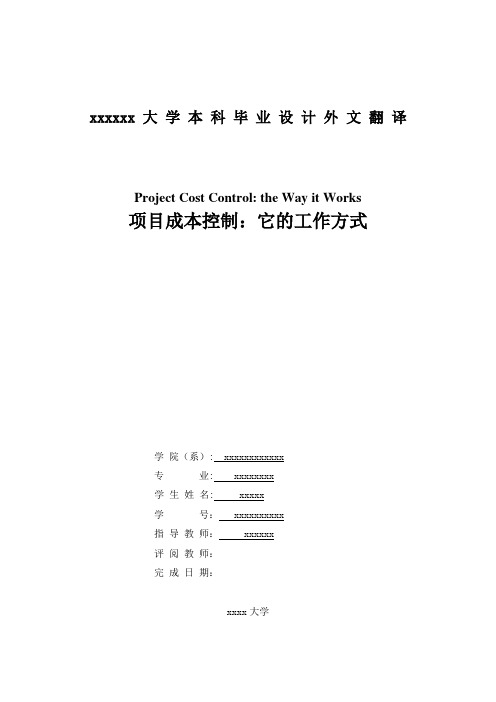
xxxxxx 大学本科毕业设计外文翻译Project Cost Control: the Way it Works项目成本控制:它的工作方式学院(系): xxxxxxxxxxxx专业: xxxxxxxx学生姓名: xxxxx学号: xxxxxxxxxx指导教师: xxxxxx评阅教师:完成日期:xxxx大学项目成本控制:它的工作方式在最近的一次咨询任务中,我们意识到对于整个项目成本控制体系是如何设置和应用的,仍有一些缺乏理解。
所以我们决定描述它是如何工作的.理论上,项目成本控制不是很难跟随。
首先,建立一组参考基线。
然后,随着工作的深入,监控工作,分析研究结果,预测最终结果并比较参考基准。
如果最终的结果不令人满意,那么你要对正在进行的工作进行必要的调整,并在合适的时间间隔重复。
如果最终的结果确实不符合基线计划,你可能不得不改变计划.更有可能的是,会 (或已经) 有范围变更来改变参考基线,这意味着每次出现这种情况你必须改变基线计划。
但在实践中,项目成本控制要困难得多,通过项目数量无法控制成本也证明了这一点。
正如我们将看到的,它还需要大量的工作,我们不妨从一开始启用它。
所以,要跟随项目成本控制在整个项目的生命周期.同时,我们会利用这一机会来指出几个重要文件的适当的地方。
其中包括商业案例,请求(资本)拨款(执行),工作包和工作分解结构,项目章程(或摘要),项目预算或成本计划、挣值和成本基线。
所有这些有助于提高这个组织的有效地控制项目成本的能力。
业务用例和应用程序(执行)的资金重要的是要注意,当负责的管理者对于项目应如何通过项目生命周期展开有很好的理解时,项目成本控制才是最有效的。
这意味着他们在主要阶段的关键决策点之间行使职责。
他们还必须识别项目风险管理的重要性,至少可以确定并计划阻止最明显的潜在风险事件。
在项目的概念阶段•每个项目始于确定的机会或需要的人.通常是有着重要性和影响力的人,如果项目继续,这个人往往成为项目的赞助。
成本控制外文翻译

成本控制外文翻译企业成本控制外文翻译有英文原文和翻译英文:36863字符中文:10000多字企业的特点与内部控制重大弱点对萨班斯法案第404评估Stephen Bryan威克森林大学巴布科克管理学院Steven Lilien纽约州立大学巴鲁学院摘要著名的萨班斯法案(SOX)要求公司评估其内部控制的财务报告并且报告存在的重大错误,这些重大错误石油公公会计监督委员会规定的。
基于早期的证据,我们发现,那些有重大错误的企业,和他们相对应的产业同行相比,他们的决策者团队更小更糟。
我们还发现,那些有重大错误的企业,平均上,具有较高的投资和风险系数,也就是这些公司拥有市场提供给他们的更高的折扣。
从宏观经济学的角度看,那些报告有重大错误的公司的市场总价值只有S&P500强企业的市场价值的1.28%。
最后,虽然我们将不良股票归纳在重大错误的报告中,通过一个很小的间隔,这些是无不足道的。
建立小企业,在对于所有企业来说建立企业都是非常高成本的环境下,貌似是非常不公平的。
萨班斯法案是否会带来企业效益,通过更好地运作,降低资金成本,或其他方式还有待观察。
此外,如果这些利益实现,是否应该,实际上是立法的,是一个有争议的问题的。
虽然有些人坚持认为萨班斯法案会减少盈余管理,公司继续通过盈余管理盈余预估。
此外,虽然美国证券交易委员会的注册G号,也立法颁布萨班斯法案的一部分,使系统“通过试算收入的”有管理的披露更为透明,它不能行使收益控制权的和解进程,企业使用这两种设置,满足分析师估计。
Characteristics of Firms with Material Weaknesses in Internal Control: An Assessment of Section 404 of Sarbanes OxleyStephen BryanBabcock Graduate School of ManagementWake Forest UniversitySteven LilienBaruch CollegeCity University of New YorkAbstract The legislation known as Sarbanes Oxley (SOX) requires firms to assess their internal controls over financial reporting and to report material weaknesses, as defined by the Public Accounting Oversight Board. Based upon early evidence, we find that firms with materialweaknesses are, on average, both smaller and worse performers than their matched industry counterparts. We also find that firms with material weaknesses, on average, have higher betas, suggesting a higher discount by the market for these firms. From a macro-economic view, the total market value of firms with reported material weaknesses is only 1.28% of the market value of the S&P 500 firms. Finally, although we document negative stock returns on the date of the announcement of the material weakness, over a narrow interval, the returns are insignificant. Identifying small firms that collectively constitute a minor portion of the economy at a very high cost to all public firms seems out of balance. Whether SOX will yield benefits to corporations through better operations, reduced cost of capital, or other means remains to be seen. Moreover, if these benefits materialize, whether they should, in effect, be legislated is a matter of debate. Although some maintain that SOX will reduce earnings management, firms continue to manage earnings through pro forma earnings. Furthermore, although t he SEC’s Reg G, also enacted as part of SOX legislation, makes the “managed disclosure system” through pro forma earnings more transparent, it fails to exercise control over the reconciliation process that firms use both to set and to meet analyst earnings estimate.。
制造企业的成本控制模式的设计与研究(英文原文,外文翻译请搜索同名word文档)

Design and Research of the Fine Cost Control Mode of Manufacturing EnterprisesChao ying ZhangBeijing Institute of Petrochemical TechnologyBeijing, China, 102600e-mail: zhangchaoying@Abstract—By using the mode like cost planning, fix-amount con-sumption and cost difference, the traditional cost-control mode focus on management of process, such as purchasing process, production process and inventory process. However, there are many disadvantages concerning this mode, like delayed plan de-veloping, complicated allocation way, obsolete methods and mis-played main body of internal cost management. Based on meticu-lous management theory, this article designs meticulous cost-control mode of manufacturing, the main features of which are that the mode use the development strategy of enterprise as the starting point and use processing cost control, meticulous cost accounting, graphic cost analysis and continuing cost improve-ment as basic framework.Keywords-manufacturing enterprises; meticulous; cost management; control modeI.I NTRODUCTIONAs a management concept of the modern industrial age, lean production (LP), also called the Toyota Production System (TPS), was proposed earliest by Japanese enterprises in the 1950s. Focusing on “eliminating all waste”, LP tries to elimi-nate any useless movements, avoid ineffective efforts and re-fuse useless materials in production and make efforts to estab-lish an enterprise mode that “eliminates all activities that can-not benefit the end users of products or services and keeps seeking and executing improvement methods”.In the 21st century, DMI took the lead in summing up and systemizing the new management modes and technologies of modern enterprises and proposed a fine management theory in China. In 2007, the fine management theory began to be gener-ally unrecognized by Chinese enterprises. Since early 2007, with the rise of raw material prices and labor costs and the ap-preciation of the RMB, the business environment of Chinese enterprises has changed dramatically, which is a sign of the coming of the high-cost age of Chinese enterprises. The in-creasingly rising costs have not only narrowed the profit mar-gins of Chinese enterprises but also highlighted their internal management problems and cost waste problems. “High inven-tory cost”, “high delivery cost” and “high accounts receivable cost” have become the three biggest disadvantages of Chinese enterprises. When the external environment is favorable, these problems are easy to be ignored by enterprises, and when the external environment is unfavorable, the adverse effects of the cost control problem will be highlighted and enterprises will have to suffer narrowed profit margins as a result of increas-ingly rising external costs and face an internal cost waste crisis as well. It is particularly important under these double threats to strengthen the cost management of enterprises and find out a fine cost control mode suitable for Chinese enterprises.II.F INE MANAGEMENT THEORYA.Concept of fine managementFine management “is a management concept and technol-ogy making each unit of an organization function in an accu-rate, effective, cooperative and continuous way through sys-tematization and detailing of regulations as well as sequencing, standardization, datamation and informatization”. It is a neces-sary requirement of the detailing of both the social division of labor and service quality for modern management. It is a basic idea and management mode based on routine management and making routine management go deep. It is also a management mode mainly aiming to minimize the resources used and cut down management costs.B.Characteristics of the fine management theoryStressing the importance of people. The most essential thought of fine management lies in changing the thinking pat-terns of people. Overcoming fixed patterns of thinking and doing creative thinking is the basis of fine management. To realize fine management, it is necessary to indoctrinate the staff with its significance, necessity and realizability and create a cultural atmosphere for staff to pursue refinement from their thoughts.Overall control and process control. Fine management the-ory emphasizes the transformation of modern management from the extensive mode to the intensive mode and the trans-formation from the traditional experience of management to scientific management. Cost management is no longer a pre-sentational concept but an all-around and staff-inclusive com-plicated management system embodied in the whole process of production and the management of an enterprise.Concept quantification. The fine management theory be-lieves that a most essential point in enterprise management is that the management at all levels must have a philosophy that things must be made delicate as detail is the key of success, have a clear understanding of the specific degrees of manage-ment indexes, efficiencies and execution and make everything operable, realizable and controllable.___________________________________ 978-1-61284-441-1/11/$26.00 ©2011 IEEEC.Significances of the fine management theory for costcontrolFollowing the cost reduction concept of “fine internal ad-justment and quick adaptation to the external environment”, actively promote technical progresses and production process optimization, minimize high-cost pressure and realize effective and low-consuming production and management.Emphasize the establishment of a perfect process center through continuous improvement. Change with the external environment, establish smooth and simple operating processes and realize effective operations of enterprises.Emphasize exactness with quantification and highlight the accuracy and importance of various data and the quickness and timeliness of information transfer.Emphasize the construction of leadership and establish an effective organization system and a perfect management sys-tem.III.A NALYSIS OF THE PROBLEMS OF THE TRADITIONALCOST CONTROL MODEA.Traditional cost control modeThe traditional cost control mode emphasizes process man-agement. It realizes cost control for the purchase process, the production process and the inventory process by means of planned costs, rated consumption of products, apportionment of cost variance, etc.TABLE I. T RADITIONAL COST CONTROL MODEB.Problems of the traditional cost control modex Problems in the calculation of quota costs and norm costs: A planned cost is a standard cost obtained on thepremise that both the existing production technologiesand management conditions are the best and optimal.However, there may be diversifying problems and dif-ficulties in practice that make it impossible for the ac-tual cost to be optimal. A quota refers to a preset quan-tity of the resources to be consumed by the unit con-forming product that is finished. Due to the everchanging internal situations of enterprises, the quotastandard only suggests situations in the past and cannotmeet future requirements, thus it is difficult to play itsdue role directly in present production and manage-ment.x Complex apportionment manners: When in indirect cost apportionment, calculate the cost apportionmentratio and then multiply it by the standard apportion-ment quota of each kind of product to obtain the indi-rect factor costs for each kind of product. The processfrom accumulation to apportionment is complex in op-eration and the result is not always so accurate and rea-sonable.x Outdated management methods: In the traditional cost management thought of Chinese enterprises, only costreduction exists and the method to obtain a larger profitmargin by promoting production efficiency is neverconsidered; “increasing incomes’ is excessively high-lighted and “reducing costs” is ignored. As a result, en-terprise information can neither really reflect the man-agement process nor provide cost information of eachoperation link, thus misguiding the preparation of themanagement strategies of enterprises.x Mistakes of the internal cost management bodies of en-terprises: It has long been misunderstood by peoplethat cost control is the work of financial personnel andmanagement only and both cost and benefit should bethe responsibilities of the leaders and financial depart-ments of enterprises. In such a misunderstanding, theroles of workshops and grass-roots departments andemployees are ignored. Consequently, the grass-rootsdepartments and the workers at the production lineshave weak cost consciousness or even have no marketpressure, resulting in serious waste of enterprises andmaking it difficult to make cost control really effective.IV.D ESIGN OF THE FINE COST CONTROL MODE OFMANUFACTURING ENTERPRISESA.Cost characteristics of manufacturing enterprisesCosts happen in business processes. Business processes mainly include material purchases, finished product production, product sales, product development and technical service, man-agement, financing and so on. The cost of production items mainly refers to purchase costs, manufacturing costs, selling costs, the trial production and period charges of new products, etc.TABLE II. B USINESS P ROCESS & COSTSB usiness Costitems Materials Procurement ProcurementcostsProduction Manufacturingcostssales Cost of salesDevelopment Trialcosts -ManagementǃServicesǃFinancing Expenses for the periodThe cost of production items is predictable. Through ac-counting on the premise of the going concerns of an enterprise,all the cost items of the enterprise are knowable or predictableunder normal circumstances. Thus, effective cost control isusually realized through a planned cost method, a standard costmethod or another method.Costs are greatly affected by economic development. A manufacturing enterprise needs to consider its purchase costsand inventory costs. Its purchase cost may increase with theprice rise of raw materials as a result of the growth of the econ-omy. It can properly increase its inventory to decrease the losses due to the price rise of raw materials. However, if exces-sive raw materials are purchased, its inventory cost will in-crease and too many funds will be occupied, making it easy to suffer a decline of fund utilization rate.Cost control should be done based on enterprise strategies. In recent years, the research on enterprise strategies has drawn wide attention and it has become a common view that cost con-trol plans should be prepared based on enterprise strategies.B. Design principles of the cost control mode of manufacturing enterprisesPrinciple of being subordinate to strategies: Both the start-ing and ending points of the cost controls of enterprises should be subordinate to their development strategies. The develop-ment strategies of enterprises are overall plans about the sur-vival and development of enterprises and the source of all the activities of enterprises. Thus, it is necessary during the design of cost control modes to plan for the cost control objectives of enterprises based on the strategic targets of enterprises and finally check whether the cost control objectives are reasonable or not through the fact of whether the strategic targets of enter-prises are realized or not.Principle of fine control: It means that cost control is not limited to the production process but covers links like new product development, material purchases, warehousing, opera-tion sites, enterprise assets, sales, etc.Principle of process standardization: It has three meanings: Detailing of processes: Prepare processes for all the production and management courses of an enterprise according to its char-acteristics and do not ignore each detail of control. Detailing of control points: Set each point in a process that may cause costs to be a control point. Quantification and standardization: De-sign each control point to be a quantized cost control objective that must comply with the overall objective. C. Mode designFigure 1. Cost Control refinement FlowProcess cost control: First, realize process reengineering while breaking down the overall cost objective step by step, then carry out fine cost control in all the links from new prod-uct development to sales.Figure 2. Cost Control refinement FlowFine cost accounting: It means that each link of a processneeds fine cost control.Figure 3. Cost control New Product DevelopmentThe emphasis of the cost control in the new product devel-opment is an economic feasibility analysis that should be done in the aspects of short and long-term impacts, extent of cost reduction, extent of profit increase and so on to make newproduct development necessary and accurate.Figure 4. Purchase Cost ControlControl the purchase cost according to the prepared system of a price compared purchasing system or purchasing through bidding and material quality standards. Meanwhile, work out an overspending plan to strictly standardize the purchase be-haviors.Figure 5. Storage cost controlWork out material turnover indexes, material management methods (such as ABC management method), material ac-counting methods and waste recovery indexes to intensify thewarehousing management.Figure 6. manufacturing process cost controlField management mainly refers to production process management. The best manner of production process manage-ment is the activity-based cost method in which the direct costs are directly charged to product cost and the indirect costs are first accumulated to different operations and then apportioned to different products. In this way, the accuracy of cost calcula-tions is ensured and the apportionment is less complex.Figure 7. Assets controlWhen carrying out cost control, classify the assets first and then use different control methods according to the classifica-tion results. Generally speaking, cost-benefit analysis is done to check the profits brought by the funds occupied and handle thenon-performing assets in a timely manner.Figure 8. Sales controlThree key points of the detailing of sales process: First, the training of sales personnel: Sales plans are key assessment in-dexes for the completion of overall tasks and the preparation of sales plans mainly depends on sales personnel’s sales capabili-ties and their loyalty to enterprises; second, fining of indexes: When setting sales tasks, use multiple indexes and weights, reflect the sales strategies of companies, set sales objectives on a quarterly basis and conduct real-time inquiries about the completion situations of the sales objectives. Third, assessment of sales personnel: Work out related indexes and then conduct regular assessments according to the indexes and establish a reward system and a ranking system to mobilize the initiative sales personnel.Graphical cost analysis: The products produced by manu-facturing enterprises have many varieties, parts and universal parts that cannot be clearly described in words only and will be more intuitive and clearer if described with flow charts by de-partments, processes and operation activities, thus benefiting the supervision over the cost condition of each link.Continuous cost improvement: In recent years, enterprises are developing faster and faster. The innovations about both the theories and practices of modern enterprise management keep emerging and enterprises are facing increasingly fierce compe-tition. Therefore, in order to minimize costs, improve produc-tion efficiency, promote quality and ensure leading target cost and control level, it is necessary to make continuous improve-ment to adapt to the development of both social economy and enterprises.V. R ESEARCH CONCLUSIONSAll the economic activities of enterprises must serve the development strategies of enterprises, so the starting and end-ing points of cost control should be the development strategies of enterprises.The overall cost objective of an enterprise should be a key part of the development strategy of the enterprise and when in cost control, it is necessary to start from the overall cost objec-tive and realize process reengineering while decomposing the overall cost objective and then design the fine cost control mode for each link of each process.Reflect the cost control mode of each link of each process through graphs to ensure both an intuitive effect and conven-ient supervision. It is necessary to do continuous improvement for the stan-dards and indexes of processes with production development and technical progresses to adapt to new situations.R EFERENCES[1] FAN Jinxiang, AN Qi. Improving quality assurance Implementingmeticulous management. Mining & Processing Equipment, 2010(06), P20-21[2] ZHENG Jianfeng. Simple Study on Meticulous Management ofConstruction Enterprises. Construction Economy,2009(06). P115-116 [3] SUN Xin,XIA Qing. Power Grid Operation Mode Based on ElaboratingManagement, Automation of Electric Power Systems.2008(21),P14-17 [4] Liu Yong Wang Qian. A Discussion On The Construction Of ResearchFunds Meticulous Management System In University. Bulletin of National Natural Science Foundation of China. 2008(05),P305-308[5] Zhu Haiji, Liu Dong, Yang Jian. The Application of Fine Managementfor Distribution Line Losses in Huangpu District. Electrotechnical Application. 2008(17),P78-79[6] TAO Hong-hui,CHEN Zheng,MENG Hongbo. Application of Lean Management inHospital Drug Storehouse Management. China Pharmacy,2008(04),P274-275[7] ZHANG Ming-hua, HUANG Sheng. Lean Shipbuilding——Study ofJapanese Shipbuilding System, Ship Engineering. 2005(02), P128-130 [8] WANG Ruihua1, ZHANG Bixue1, CHENG Dacheng Analysis of thefine cost management applied to oil companies. Journal of Liaoning Technical University(Social Science Edition), 2010(04), P369-371[9] LI Yongju, ZHAO Jujie. Application of Comprehensive CostManagement in Construction Enterprises. Construction Technology. 2006(05), P42-43[10] WU Xiangjiang. On Knowledge and Practice of Fine Management.Journal of Hangzhou Institute of Financial Studies. 2004(07), P31-33。
- 1、下载文档前请自行甄别文档内容的完整性,平台不提供额外的编辑、内容补充、找答案等附加服务。
- 2、"仅部分预览"的文档,不可在线预览部分如存在完整性等问题,可反馈申请退款(可完整预览的文档不适用该条件!)。
- 3、如文档侵犯您的权益,请联系客服反馈,我们会尽快为您处理(人工客服工作时间:9:00-18:30)。
原文题目:《成本控制》作者:罗杰·奥比纳得原文出处:Reference for Business, Encyclopedia of Business, 2nd ed.成本控制成本控制,也被称为遏制成本或管理成本,一个广阔的成本管理技术,它的经济增长目标是降低成本提高企业效率。
企业使用的成本控制方法,监测,评价,并最终提升效率的具体领域,如部门、产品线。
20世纪90年代的成本控制措施,受到了美国企业的首要关注。
一般而言,外包企业重组、撤资的外围活动,大规模裁员等成本控制战略被认为是升提升企业利润和维持企业竞争优势的需要。
其目的往往是降低企业的生产成本,这样该企业给出的销售价格就比其竞争对手具更大的利润。
一些成本控制的支持者认为,这种战略的成本削减计划必须慎重,因为并非所有降低成本的方法,都会对企业产生有利的影响。
在20世纪90年代的一个显著的例子,首席执行官邓拉普,绰号“电锯阿尔”,尽管他大幅降低企业的生产成本,但他领导的小器具制造公司依旧未能盈利。
邓拉普解雇了成千上万的工人和出售企业的业务,在他担任CEO两年内贡献不大,公司的竞争地位和股票的价格大幅下滑。
因此,在1998年公司董事会解雇了邓拉普,对他“成本控制一招”的管理方法失去了信心。
成本控制是一个持续的过程,与拟议的年度预算配合使用。
该预算有助于:(1)组织、协调生产和销售、服务和管理职能;(2)采取最大程度地利用现有的机会。
根据财政历年的进步形式,将预算与实际结果作比,生成新的计划和经验教训,用以评价目前的行动。
控制是指通过管理层的努力来影响个人的行为,由谁负责执行任务,承担成本,并获得收入。
管理是一个过程,将其分为两个阶段:规划是指管理计划的方式,希望人们人们能够执行的程序,而控制是指受雇于这些计划的程序是否符合实际表现。
通过预算过程管理和会计控制、建立全面的公司目标,明确责任中心,确定各责任中心的具体目标,设计的程序和标准报到和评价。
一个分部的业务纳入预算的组成部分,由责任方控制的。
责任中心适用于组织单位和职能部门。
通常一个人单独负责的责任中心更具实质性,如果控制活动不彻底,中心控制的人在活动过程中,难以得到预期的活动结果。
成本中心只负责管理费用,也就是说,他们不产生收益。
例如会计部门,人力资源管理部门,内部服务和类似提供内部服务的部门。
利润中心承担利润和费用的收入责任。
例如,生产线或一个独立的业务部门可能会被认为是利润中心。
如果利润中心有自己的资产,它也可被视为一个投资中心,由此才能确定投资回报。
责任中心使用的控制报告使管理者更具责任性,并且有助对利润的计划。
预算案还规定了参考标准,表明了这次活动的级别、各单位负责人、能使用的资源及预期出现的结果。
建立一个预算责任中心,规定其责任中心代表所承担的责任,并确定组织内的决策点。
规划过程提供了两种控制机制:前馈:提供一个在行动点(决策点)控制的基础;反馈:提供一种测量实施后的控制基础。
管理层的作用是引导公司未来的走向,明确决策,协调和指导员工活动。
管理部门还通过发展监督程序,收集、记录、评估反馈。
因此,有效的管理控制结果,是通过制定计划,提供资源,进行适当的培训,引导员工的集体组织意识,从而提高评价和反馈的质量及结果。
控制报告是告诉管理者一个实体的活动的管理信息报告。
管理层提出控制报告仅供内部使用,因此,指示财务部门发展量身订作的报告格式。
会计向管理层提供一种格式来检测管理的变化。
此外,管理层还提到了企业的对外报告和特定行业的常规报告如损益表和资金报表。
控制报告能提供管理层足够的信息量,使管理人员可从最初的预算中分析的成本差异的原因。
一个好的控制报告能突出不同管理层所需的重要信息。
由于企业成功的关键因素(如种类和数量)是在变化的,所以会计控制报告必须及时修改。
会计期间各不相同的控制报告必须涵盖整个期间,由此管理层才可以采取有效的补救措施。
此外,会计控制报告的及时传播,给管理层足够的时间采取行动。
当进行有效的管理,企业达到的目标将和预算确定的目标一致。
管理者成功的程度取决于利润,管理人员在行动的时应意识到自己更有效地对费用进行控制取得的收入也会更多。
虽然他们不能预测销售的时间和实际销售数量,他们可以决定他们的大部分资源的利用率,也就是说,他们可以影响成本方面。
因此,管理性能的优良可从其运作的成本控制方面进行评价。
出于成本控制的目的,预算规定了企业的标准开支。
正如管理结构的预算,它勾画出一个路线图,指导企业的工作。
它阐述了一定销售数量的假设条件下,企业的经济关系和互动能力,市场动态,它的销售队伍,及其承载力,以提供正确的数量和质量要求。
会计在企业的规划和控制中扮演了一个关键角色。
它渗透在以下四个关键领域:(1)数据收集,(2)数据分析,(3)预算控制和管理,以及(4)整理和审查。
会计师事务所在设计和获取支持程序方面的规划过程中发挥关键作用。
此外,他们还收集和传播企业用于销售和预订有关的详细资料。
经营管理人员有责任对企业各元素进行规划、编译和协调,并根据会计科目的可行性及预算利润率的分析来确定符合公认的标准和规范。
管理者依赖会计数据和分析选择不同形式的成本控制方案,管理者可以指导会计部门专门准备这些期权报告的评估。
电锯阿尔事件说明,削减大部分费用成本的措施不可作为实施可行目标的途径。
例如,在大规模裁员中,该公司可能会失去它的很大一部分人力资本裁掉的老员工可能是他们领域的专家。
因此,管理层必须确定哪些成本具有战略意义。
确定削减成本的战略冲击,管理者必须斟酌提出的变动对所有事务区域的实际影响。
例如,降低与制造产品直接相关的可变成本,如材料和运输成本,可能是获得更大利润的关键。
但管理层还必须考虑节约生产资金是否危害其他战略利益像质量或产品进入市场的时间。
如果便宜的材料或其他运输系统会产生负面影响,这种情况下,管理者需要谨记不能因眼前好处而丢失长远利益。
成本控制中的一个趋势是缩小企业责任中心,从而将一些日常的成本控制功能进行整合。
这种做法的目的是实施自下而上的成本控制措施,并鼓励达成成本管理战略的广泛共识。
成本控制,也被称为遏制成本或管理成本,一个广阔的成本与管理技术,它的经济增长目标是提高企业效率降低成本,或者至少限制他们的发展速度。
企业使用的成本控制方法,监测,评价,并最终提升效率的具体领域,如部门,部门,或产品线。
在20世纪90年代的成本控制措施,受到了美国企业的首要关注。
一般而言,外包企业重组,撤资的外围活动,大规模裁员等成本控制战略被认为是需要升提升企业利润和维持企业竞争优势。
其目的往往是降低企业的生产成本,这样该企业给出的销售价格就比其竞争对手具更大的利润。
一些成本控制的支持者认为,这种战略的成本削减计划必须慎重,因为并非所有降低成本的方法,都会对企业产生有利的影响。
在20世纪90年代的一个显著的例子,首席执行官邓拉普,绰号“电锯阿尔”,尽管他使用大幅降低企业生产成本的策略,但他领导的小器具制造公司依旧未能盈利。
邓拉普解雇了成千上万的工人和出售企业的业务,在他担任CEO两年内贡献不大,且使公司的竞争地位和股票的价格大幅下滑。
因此,在1998年公司董事会解雇了邓拉普,对他“成本控制一招”的管理方法失去了信心。
行为管理涉及员工的态度和行为。
而员工的行为管理结果涉及的若干问题和假设不适用于会计的控制功能。
另一方面,绩效评估员工的行动措施的业务成果,是比较实际结果和预定的标准的差距。
这种管理方式的优势在于它能识别员工的行为弱点,并试图纠正其弱点。
这一补救措施的过程评价,被称为成本控制。
成本控制是一个持续的过程,与拟议的年度预算配合使用。
该预算有助于:(1)组织,协调生产和销售,分销,服务和管理职能;(2)采取最大程度地利用现有的机会。
根据财政历年的进步形式,将预算与实际结果作比,生成新的计划和经验教训,用以评价目前的行动。
控制是指通过管理层的努力来影响个人的行为,由谁负责执行任务,承担成本,并获得收入。
管理是一个过程,将其分为两个阶段:规划是指管理计划的方式,希望人们人们能够执行的程序,而控制是指受雇于这些计划的程序,是否符合实际表现。
通过预算过程管理和会计控制、建立全面的公司目标,明确了责任中心,确定各责任中心的具体目标,设计的程序和标准报到和评价。
一个分部的业务纳入预算的组成部分,责任方发起控制的行动。
责任中心是适用于组织单位和职能部门。
通常一个人单独负责的责任中心更具实质性,如果控制活动不彻底,中心控制的人在活动过程中,难以得到预期的活动结果。
成本中心只负责管理费用,也就是说,他们不产生收益。
例如会计部门,人力资源管理部门,内部服务和类似提供内部服务的部门。
利润中心承担利润和费用的收入责任。
例如,生产线或一个独立的业务部门可能会被认为是利润中心。
如果利润中心有自己的资产,它也可被视为一个投资中心,为此,才能确定投资回报。
责任中心使用的控制报告使管理设计更具责任性,从而协助对利润的计划。
预算案还规定了参考标准,表明了这次活动的级别、各单位负责人、能使用的资源及预期出现的结果。
建立一个预算责任中心,其责任中心代表所承担的责任,并确定组织内的决策点。
规划过程提供了两种控制机制:前馈:提供一个在行动点(决策点)控制的基础;反馈:提供一种测量实施后的控制基础。
管理层的作用是引导公司未来的走向,明确决策协调和指导员工活动。
管理部门还通过发展监督程序,收集、记录、评估反馈。
因此,有效的管理控制结果,通过制定计划,提供资源,进行适当的培训,引导员工的集体组织意识;从而提高评价和反馈的质量及结果。
控制报告是告诉管理者一个实体的活动的管理信息报告。
管理层提出控制报告仅供内部使用,因此,指示财务部门发展量身订作的报告格式。
会计向管理层提供一种格式来检测管理的变化。
此外,管理层还提到了企业的对外报告和特定行业的常规报告如损益表和资金报表。
控制报告能提供管理层足够的信息量,使管理人员可从最初的预算中分析的成本差异的原因。
一个好的控制报告能重点突出管理层不同部门所需的重要信息。
由于成功的关键因素(如种类和数量)是在变化的,所以会计控制报告必须及时修改。
会计期间各不相同的控制报告必须涵盖整个期间,由此管理层才可以采取有效的补救措施。
此外,会计控制报告的及时传播,给管理层足够的时间采取行动。
当他们进行有效的管理,企业将会达到的目标和预算确定的目标一致。
管理者成功的程度取决于利润,收入不断超越费用。
管理人员在行动的时应意识到自己更有效地对费用进行控制取得的收入也会更多。
虽然他们不能预测销售的时间和实际销售数量,他们可以决定他们的大部分资源的利用率,也就是说,他们可以影响成本方面。
因此,管理的性能的优良可从其运作的成本控制方面进行评价。
出于成本控制的目的,预算规定了企业的标准开支。
